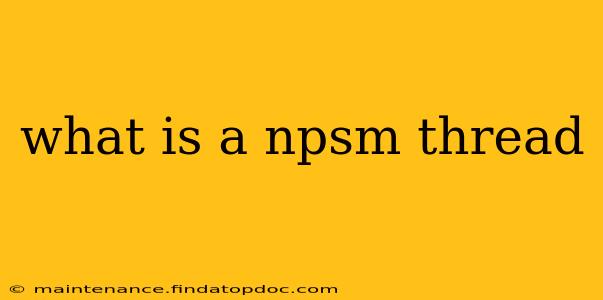NPSM (National Pipe Straight Mechanical) threads are a type of pipe thread used primarily in the United States and Canada. Unlike NPT (National Pipe Taper) threads, which have a tapered profile, NPSM threads are parallel, meaning the diameter remains consistent along the length of the thread. This key difference leads to several important distinctions in their application and characteristics. Understanding these nuances is crucial for anyone working with piping systems.
What is the Difference Between NPSM and NPT Threads?
The primary difference, as mentioned, is the thread profile. NPT threads are tapered, creating a tighter seal as the pipe is tightened. This self-sealing characteristic is advantageous in many applications, but it also makes them less suitable for situations requiring repeated assembly and disassembly. NPSM threads, being parallel, do not self-seal and require a separate sealing mechanism, like a gasket or sealant.
This leads to several practical implications:
- Seal: NPT threads rely on the taper for a seal; NPSM requires a separate sealing method.
- Reusability: NPSM threads are generally more reusable than NPT threads because they don't deform as much during assembly and disassembly. Repeated use of NPT threads can lead to leaks.
- Assembly: NPSM threads generally require a higher torque to achieve the desired tightness due to the lack of self-sealing taper.
- Precision: NPSM threads often have a higher degree of precision in manufacturing, leading to tighter tolerances.
Are NPSM Threads Stronger Than NPT Threads?
The strength comparison between NPSM and NPT isn't a straightforward "yes" or "no." While NPSM threads are generally made to tighter tolerances and can be considered more precise, the overall strength depends on various factors, including:
- Material: The material of the pipe and fitting plays a much more significant role in determining overall strength than the thread type itself.
- Thread Length: A longer engagement length in both NPSM and NPT will contribute to greater strength.
- Application: The specific application and the forces acting on the connection are key factors.
What are NPSM Threads Used For?
NPSM threads find applications where reusability and precision are essential. Some common applications include:
- Hydraulic systems: Where frequent assembly and disassembly are needed, and precise sealing is achieved through separate gaskets or O-rings.
- High-pressure applications: Although the sealing mechanism differs, proper sealing in NPSM connections, when implemented correctly, can withstand significant pressure.
- Machinery: In machinery applications, where repeated connection and disconnection is required, NPSM threads are advantageous for their reusability.
What Are the Advantages and Disadvantages of NPSM Threads?
Advantages:
- Reusability: Can be disassembled and reassembled multiple times without significant loss of seal integrity.
- Precision: Often manufactured to tighter tolerances, resulting in a more precise fit.
- Consistent diameter: The parallel profile ensures consistent engagement throughout the threaded length.
Disadvantages:
- Requires a separate sealant: Unlike NPT threads, NPSM threads don't create a self-sealing connection.
- Higher assembly torque: May require more torque to achieve a proper seal.
- Potentially more expensive: The increased manufacturing precision can lead to higher production costs.
How to Identify NPSM Threads?
Proper identification relies on understanding the marking system. NPSM threads are typically identified by markings on the fitting itself that clearly state "NPSM" followed by the size and pipe schedule. A careful visual inspection and comparing the thread profile to a known NPT thread can also aid in distinguishing them.
In conclusion, NPSM threads represent a crucial variation in pipe threads, offering advantages in specific applications where reusability and precision outweigh the need for a self-sealing taper. Knowing the distinctions between NPSM and NPT threads is paramount for anyone working with piping systems to ensure proper selection and installation.
